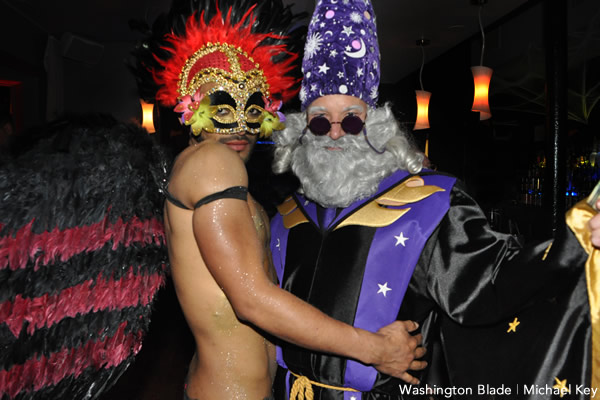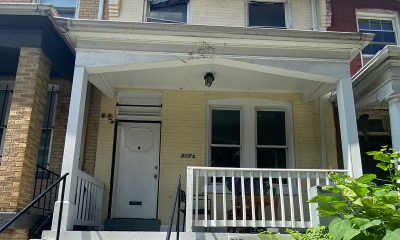a&e features
Devilish delights
Spooky Halloween fun lasts al weekend and beyond
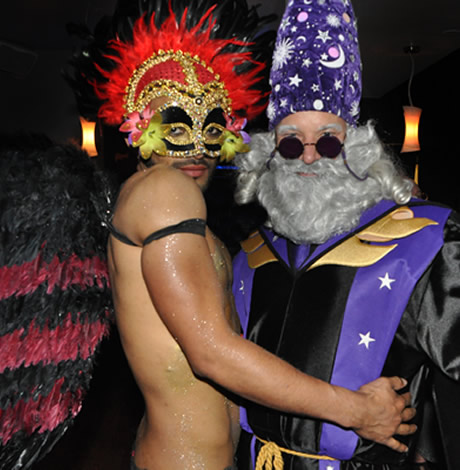
With Halloween ushering in the weekend this year and no school nights to worry about, the D.C. area has more parties, costume contests, ghost tours and more than any one person could possibly get to. Our fun guide will help give your holiday a macabre gay twist.
5 great ghost tours
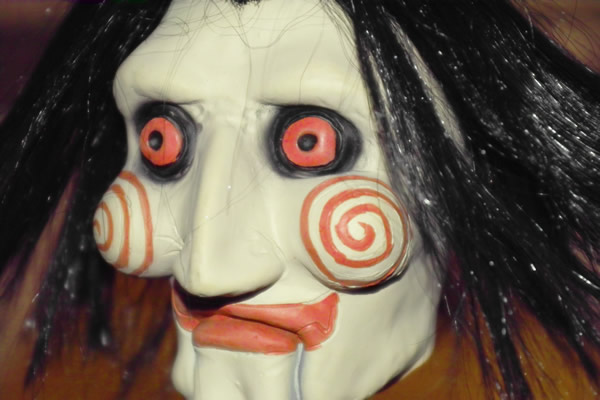
(Photo courtesy Crime Museum)
1. The Crime Museum (575 7th St., N.W.) has its sixth annual Fright at the Museum — Dead Men Walking event which continues through Saturday for those brave enough to be led through a dim-lit maze of empty jail cells, electric chairs, dark alleys and gruesome crime scenes. Tickets are $30. Details at crimemuseum.org.
2. Markoff’s Haunted Forest in Dickerson, Md., also continues through Saturday with horrifying scenes of limbo, absolution, greed, gluttony and other circles of hell. E-mail [email protected] to reserve a remaining slot.
3. Space is filling up fast but a few slots remain for the 90-minute Capitol Hill Ghost Tour, which continues through Nov. 8. For $25, you can meet up at the Starbucks at 237 Pennsylvania Ave., S.E. and be regaled with tales of hauntings in the Capitol building, the Library of Congress, the Supreme Court and more. Details at scarydc.com.
4. For hundreds of years, the homes of Lafayette Square are said to be among the most haunted of all in Washington. Ghost Story Tours meet at 16th and H streets, N.W. for private ghost tours through Saturday, though they can also be booked year around as well. Contact Natalie at [email protected] or call 301-346-5303. More information is at historicstrolls.com.
5. Sometimes it’s creepier out in the country. Actors, elaborate sets and original scary stories abound at Darkwood Manor (104 N. Hawksbill St., in Luray, Va.) where tours continue through Saturday night. Tickets are $12. Visit darkwoodmanor.net for details.
5 great neighborhoods for trick or treating
Where’s the best place to go trick or treating in the District? Depends whom you ask. CBS D.C.’s Jamie Hardin, who prides herself on finding D.C.’s “off-the-beaten-path treasures” recommends Capitol Hill, Embassy Row, Georgetown, the Smithsonian National Zoo and Old Town Alexandria as the best spots. Curbed (dc.curbed.com) recommends Friendship Heights, Chevy Chase, American University Park and Tacoma as the best spots. The only shared neighborhood on the lists is Georgetown, which Curbed ranked as the best spot for its easy walkability and affluence.
If you want to “gay it up” a bit, Ellen Kahn of Rainbow Families says her neighborhood in East Silver Spring that borders Takoma Park is rife with a cluster of nearly 20 same-sex, mostly lesbian couples with kids in the area of Richmond Avenue, Gist Avenue, Takoma Avenue, and Chicago Avenue.
“It’s always a pretty active Halloween scene there,” she says. “Capitol Hill is also a good place to find some diversity, maybe more dads too.”
On Sunday, take your gay family out to Centreville, Va., for the group’s “Fall Day at Cox Farms,” where Rainbow Families D.C. will meet up for kid-friendly slides, animals, mazes, hayrides, live music, great food and a pumpkin smashing event. The fun starts at 10 a.m. Visit rainbowfamiliesdc.org for details.
5 big-screen thrills

The ‘Exorcist stairs’ in Georgetown (Photo by Dmitry K.; courtesy Wikimedia Commons)
Viewers at Today (today.com/popculture) just voted 1973’s (No. 1) “The Exorcist” their favorite scary movie. Sixteen horror classics were whittled down to two where the final showdown was held between “The Exorcist” and (No. 2) “The Shining,” the classic 1980 Stanley Kubrick creeper.
Celebrate the film’s win — if you dare — with a visit to the famous steps in Georgetown where the movie’s climactic scene was filmed.
If you’re up for a communal experience, the AFI Silver in Silver Spring (8633 Colesville Rd.) has an eclectic lineup today with “Sleepy Hollow” at 3 p.m., “Frankenweenie” at 5:10, “Shaun of the Dead” at 9 and for a genuinely creepy experience, check out the 11 p.m. screening of (No. 3) “Rosemary’s Baby” at 11 p.m. The fun continues Saturday with a string of classic early creepers with live accompaniment including (No. 4) “Dracula” (1931), “Nosferatu” and “The Lodger,” the classic Hitchcock tale of Jack the Ripper, the Master’s third film. Details at afi.com/silver.
And if you want to gay it up, check out newnownext.com’s list of “The 13 most homoerotic horror movies of all time” which includes slasher flick (No. 5) “Hostel,” “American Psycho” and (of course!) “The Talented Mr. Ripley.”
5 great costumes
Gene’s Costumes (10636 Connecticut Ave., Kensington, Md.) has Halloween costumes for every fantasy a person wants to live out for the night. Here are some of their trendiest get-ups this season if you need some last-minute inspiration!
1. The Joker — one of the most famous villains in pop culture so it’s no surprise it’s one of the most popular costumes. It’s a quick costume to throw together because the main component is all about re-creating the tell-tale Joker makeup.
2. Pirate — Pirates can be sexy or scary depending on how you put together the costume. “Robin Hood’s” Captain Hook, another famous villain, has shown his popularity selling many at Gene’s Costumes. “Pirates of the Caribbean’s” character Jack Sparrow, made a pop culture icon by Johnny Depp, has also been a huge pirate favorite.
3. “Frozen” — The kids will love to dress up as characters from the top-grossing animated film of all time, “Frozen.” The most popular costume for girls has been Elsa and her sister Anna. While boys have been eager to dress up as iceman Kristoff and Prince Hans.
4. Flapper — One of the women’s favorite costumes has been a 1920s flapper. This costume is easy to pull together at the last minute. A loose fitting dress, cigarette holder and bob haircut wig create a look that’s both sexy and glamorous.
5. Military General — Another sexy choice is a military general. A popular men’s choice at Gene’s Costumes, this look is distinguished but fun. The authoritative costume will have people turning heads for a man in uniform.
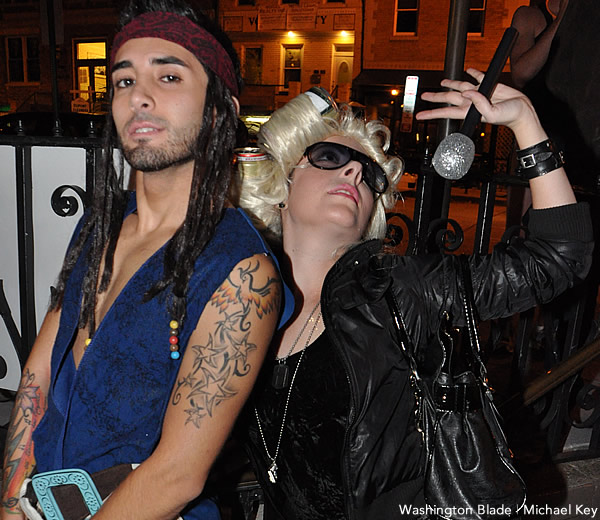
Do you have your Halloween costume yet? (Washington Blade photo by Michael Key)
Halloween gay party roundup
All parties are Halloween night (Oct. 31) except where noted.
D.C. Bear Crue hosts a Monster Bear Party at Town (2009 8th St., N.W.) tonight from 6-11 p.m. There will be a Halloween costume contest with several prizes. For more details, visit dcbearcrue.com.
Mixtape holds its third annual Halloween bash at the Howard Theatre (620 T St., N.W.) from midnight-4 a.m. Tickets are $10. For more information, visit thehowardtheatre.com.
Green Lantern (1335 Green Ct., N.W.) hosts “Not Another Drag Show: the 10th Edition” at 10 p.m. Performances will be by Sofonda Coxxx, Gladys Kravitz, Surley Bossy and many more. There will be a live auction, Halloween costume contest and drink specials. There is a suggested $5 donation at the door to benefit the Gay Men’s Chorus of Washington’s GenOUT youth outreach program. For details, visit greenlanterndc.com.
Phase 1 (525 8th St., S.E.) hosts a Halloween party “Thrillher” at 7:30 p.m. There will be a costume contest at midnight with a $300 cash prize. DJ Lez Rage will play tracks and there will be drink specials. For more details, visit phase1dc.com.
Girl Code hosts “#GirlCodeFridaze Halloween Edition,” a costume party, at Vita Lounge (1318 9th St., N.W.) from 10 p.m.-3 a.m. Admission is $10 before midnight and $15 after. Come in costume and admission is $10 all night. For more information, visit girlcodefridaze.eventbee.com.
“Treats or Freaks,” an LGBT ladies Halloween party, is at Mad Momos (3605 14th St., N.W.) from 10 p.m.-3 a.m. DJ Jai Syncere, Dj India and DJ DeeDub will provide music. Come in costume and tickets are $10 before 11:30 and $15 after, without a costume tickets are $20 all night. There will be four costume contests with cash prizes. For more information, visit dcpridebarhop.com.
Cobalt (1639 R St., N.W.) hosts “Madscience Presents: Freak Show” at 10 p.m. DJ Madscience will host the party. Sasha Adams will host the costume contest with a grand prize of $1,000. Belevedere drinks are $6 all night and there will also be an open vodka bar from 11 p.m.-midnight. For more information, visit cobaltdc.com.
Town (2009 8th St., N.W.) boasts “D.C.’s largest Halloween party and costume contest” with a $1,000 prize tonight. Details at towndc.com. A “Night of the Living Dead” party is scheduled for Saturday night.
Destiny B. Childs hosts a $500 costume contest at Ziegfeld’s/Secrets (1824 Half St., S.W.) tonight. Details at secretsdc.com.
JR.’s (1519 17th St., N.W.) has a $250 prize for its costume contest starting at 11 p.m. Details at jrsbar-dc.com.
Number Nine (1435 P St., N.W.) holds a Halloween party at 10 p.m. hosted by Peaches. There will be a costume contest starting at 11 p.m. with a prize of $250 in cash and a $250 Number Nine gift card. For more details, visit numberninedc.com.
The Mansion on O Street (2020 O St., N.W.) hosts a Halloween costume party from 8 p.m.-midnight There will be a DJ, prizes, a chocolate fountain, pumpkin decorating contest and a treasure hunt. During the party guests will have the opportunity to explore the 100 rooms in the mansion. There is also a cash bar. Costume contest categories include best couples costume, most creative, scariest costume and more. Tickets are $50. For more information, visit omansion.com.
United Solders and Sailors of America host Trick or Treat, a Halloween costume fundraiser, at the Ugly Mug (728 8th St., S.E.) tonight from 8 p.m.-midnight. There will be raffle items and a costume contest. Wristbands are $10 for food and drink specials. Proceeds from the event will go toward care and comfort items for Walter Reed Military Medical Hospital. For more details, visit facebook.com/usaoa.
Onyx presents The Blackout Ball at MOVA Lounge (2204 14th St., N.W.) Saturday from 10 p.m.-2 a.m. Guests should bring a mask. There will be strippers, raffle prizes and a cash bar. Cover is $10. For details, visit facebook.com/onyx.midatlantic.
The Yards Park (355 Water Street) hosts “Graveyards at the Yards Park,”a Day of the Dead festival, Saturday from 6-10 p.m. The park will be transformed into a graveyard with magicians, escape artists, contortionists, fire artists and much more. There will also be a mariachi band and performance by rock-folk band Kingsley Flood. Admission is free. For more information, visit theyardsdc.com.
a&e features
Queer TV anchors in Md. use their platform ‘to fight for what’s right’
Salisbury’s Hannah Cechini, Rob Petree are out and proud in Delmarva
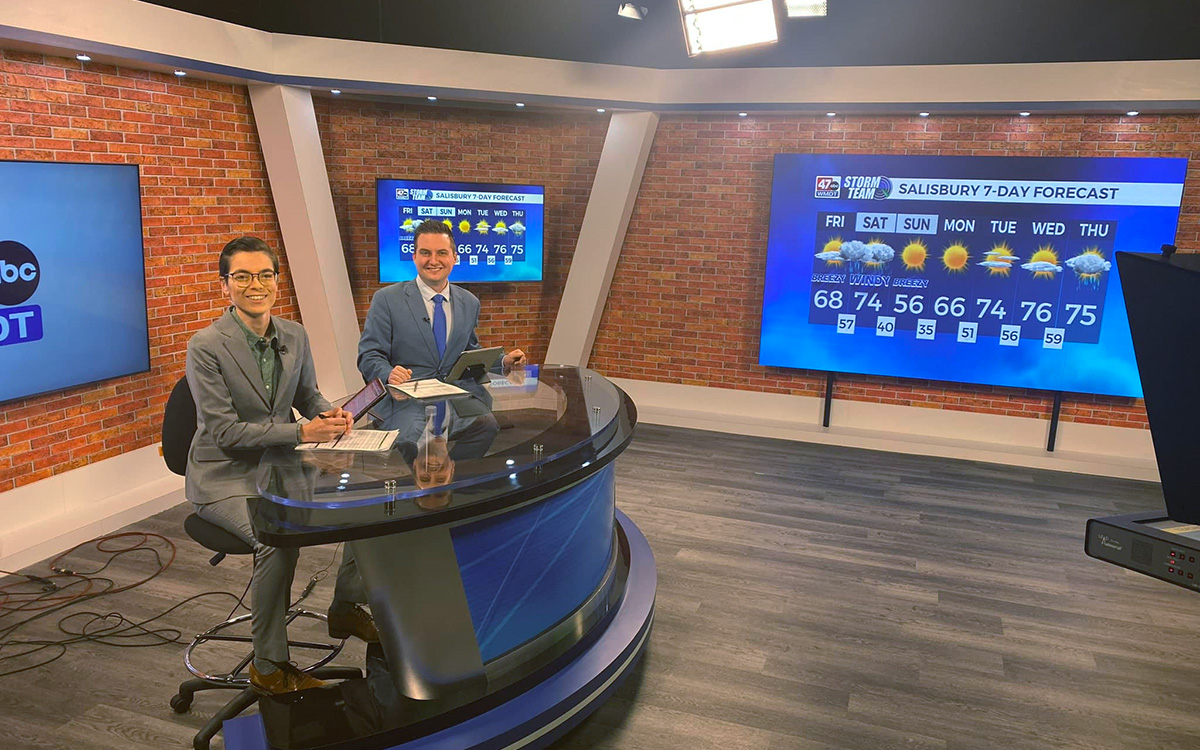
Identity can be a tricky thing for journalists to navigate. The goal of the job is to inform the public with no bias, but this is difficult, if not impossible, to do in practice. Everything from your upbringing to the books you read can impact how you view and cover the world. But sometimes these factors can help shine a light on an underrepresented community or issue.
Two broadcast journalists in Salisbury, Md., are using the subtle, yet impactful choice of sharing their queer identities to strengthen their reporting and connection to the community.
Hannah Cechini, who is non-binary, and Rob Petree, who is gay, co-host the 5:30-6:30 p.m. newscast for WMDT 47. They are the only known anchor team that are not only both queer, but also open out about their identities on air and, as Petree put it, “always use [their] platform and power that [we] have to fight for what’s right.”
Cechini’s passion for journalism played an important role in the discovery of their gender identity. They knew they were meant to be in the newsroom before they figured out they were non-binary.
“I was doing this job before I started to identify as non-binary,” Cechini told the Blade. “I’d always watch the evening news with my dad growing up and thought it was the coolest thing. And throughout high school, I worked on the school paper.”
After graduating from Suffolk University in Boston, Cechini’s passion for journalism only grew as they began to work in the world of news media, eventually ending up in Salisbury. As they honed their writing, editing, and anchoring skills at WMDT, Cechini also started to take an introspective look into their gender identity.
A little more than two years ago Cechini came out as non-binary to their coworkers in the newsroom and was met with support all around. “It was definitely smoother than I anticipated,” they said.
“It is very freeing to be able to do this job as a non-binary person because I haven’t really seen much of that representation myself.”
Petree, on the other hand, knew he was gay right around the same time he became interested in news media, at age 14. He started working for his high school news show and used it as a way to be open about his sexuality rather than hide it.
“I broke into broadcasting doing the morning announcements,” he said. “I did the weather and started doing a segment called issues and insights,” Petree said, explaining his introduction to the news. Eventually, students would ask him questions about his sexuality after seeing him on the school TV. “It had gotten to the point in school, that if you’re going to come up and ask me if I’m gay, well shit, I’m going to tell you!”
To him, this was the exact reason he had come out. Petree wanted to motivate others to live honestly.
“There are a lot of people who will spend most of their lives not being out so if they can see someone like me, who’s out and proud doing his thing, so to speak, then maybe that’s the inspiration for them,” Petree said. “To search their own soul, find out who they are, and live their full life.”
Petree explained that he got his start in a space that was not always welcoming to his queerness. This tested the delicate balance between being a journalist and holding your identity close.
“I’ve always been out and it was a challenge because I got my start in conservative talk radio,” Petree said. “I’m going to be honest, some of the things I heard from people I’ve worked with, from the callers to the radio stations were absolutely abhorrent. But I never let it discourage me. It made me work that much harder.”
Cechini highlighted the same sentiment when explaining why it’s important to have out LGBTQ figures in news media. They want to show everyone that it is possible to be openly queer and successful.
“I just think that representation matters because if ‘Joe,’ who’s never seen a transgender person before, sees a transgender person or a non-binary person, doing a job that they’ve only ever seen straight cis people doing before, it kind of creates that understanding or bridges that gap,” Cechini said. “It’s like, ‘OK, maybe they’re not that different from me.’ And that facilitates being able to connect among different communities.”
Both Cechini and Petree agree that having a queer coworker has made their bond stronger.
“It’s great to have someone else next to me who I can relate to and work alongside,” Petree said. “And they’re a joy to work with, they really are. There is a tremendous amount of things that we relate to together — like we both share and have the same affinity for Lady Gaga,” he said laughing. “Although they’re more of a Lady Gaga fan than I am.”
“Hannah is a tremendous journalist who really goes out of their way to make sure that the stories that they do are on point 100% of the time,” he added. “They’ve been great to work with and to learn from and to grow alongside. I’m very happy to have them as my co-anchor.”
Cechini explained that the relationship between two co-anchors can make or break a newscast, and having Petree as their partner on air is a major part of the show’s success.
“Co-anchoring is not just the relationship that you have on camera,” Cechini said. “It’s really, really important to have a good relationship with your co-anchor off-camera as well because you have to have a level of trust between you.”
Cechini continued, saying that this relationship is crucial to working together, especially when things don’t go as planned.
“Not everything always goes to script,” they said. “Sometimes you have to be able to work together without even really talking to each other and just kind of know what to do. When you have a relationship like that with someone who identifies similarly to you or has had similar life experience, I think that just only strengthens that [relationship].”
Although they have had similar experiences being from the LGBTQ community, Petree said it was a change for him to use “they/them” pronouns on air.
“Prior to working with Hannah, I’ve never worked with a non-binary individual who went by the pronouns ‘they/them,’” Petree said. “It was new for me to not use traditional pronouns on air, but I can say that I have never misgendered them on air and never will. You get conditioned to using traditional pronouns and it’s easy to make that mistake, but I never have.”
At the end of the day, they both explained, it is about doing the job right. For the duo, a part of that is understanding the diversity of people and issues in the community.
“When you come from a more marginalized community, I think that kind of helps to inform you a little better as a journalist because you have a better understanding of what it’s like to be ‘the other guy,’” Cechini said.
“Our talent and our drive for journalism speaks for itself,” Petree said. “And that resonates with people. Have we shown ourselves to be an inspiration to the LGBTQ+ community here in Delmarva? Yes, we have. And that’s something that I’m proud of.”
The primetime nightly newscast with Hannah Cechini and Rob Petree airs weeknights from 5:30-6:30 p.m. on ABC affiliate WMDT 47.
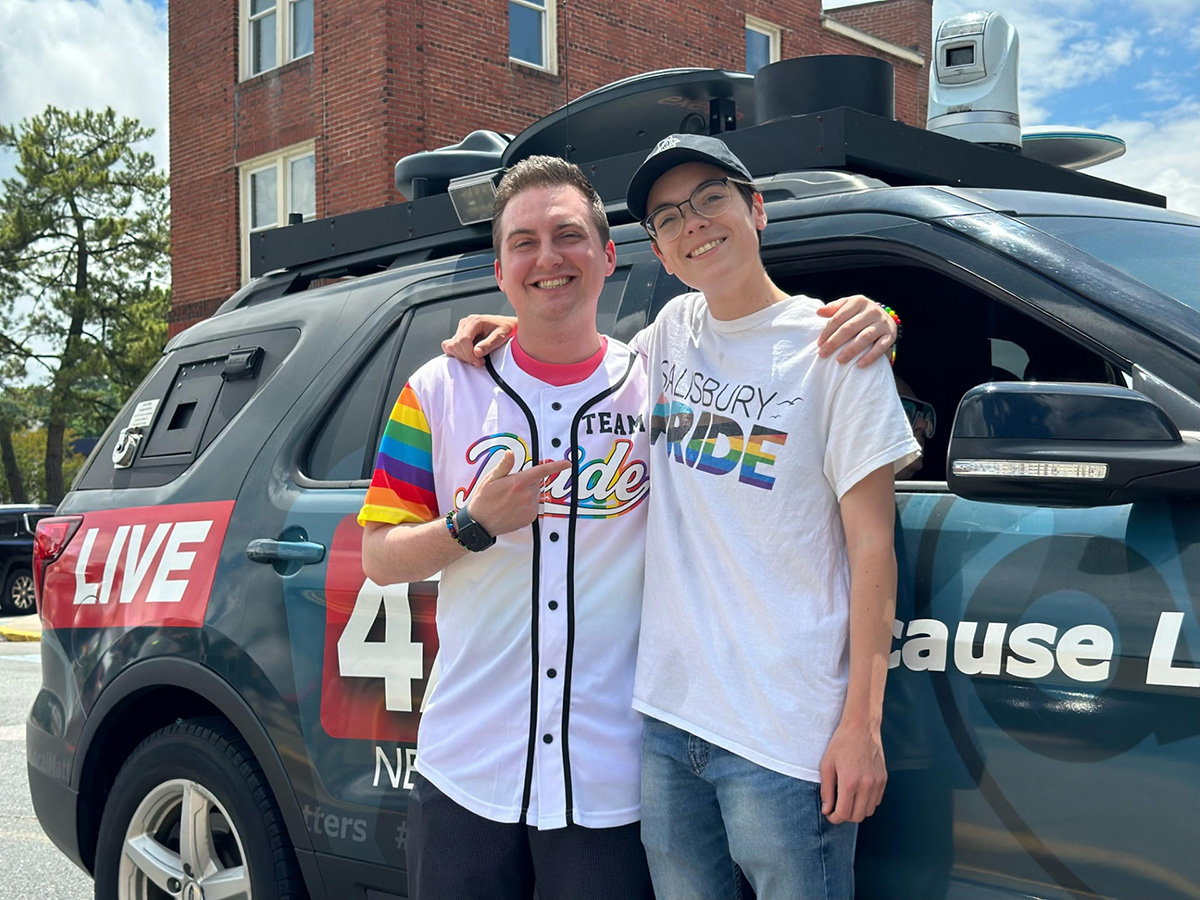
a&e features
‘Queering Rehoboth Beach’ features love, loss, murder, and more
An interview with gay writer and historian James T. Sears
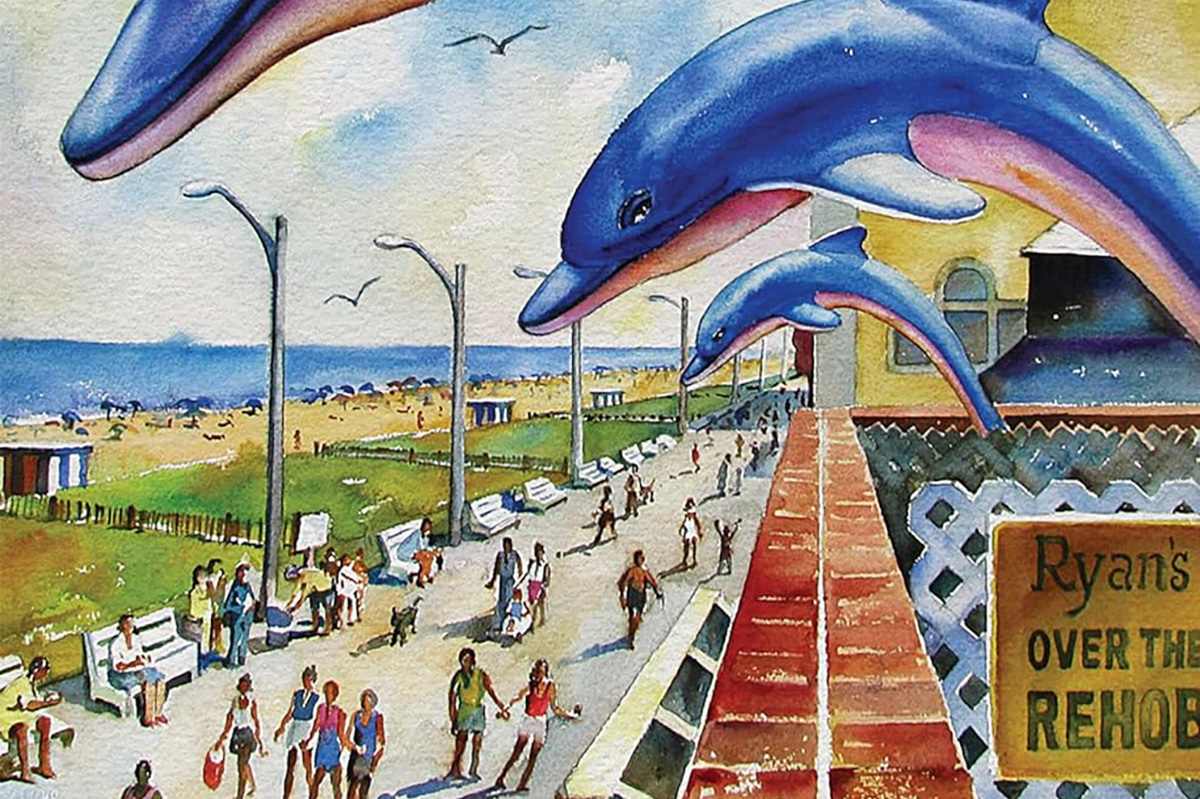
James T. Sears book talk
Saturday, June 29, 5 p.m.
Politics & Prose
5015 Connecticut Ave., N.W.
When it comes to LGBTQ summer destinations in the Eastern time zone, almost everyone knows about Provincetown, Mass., Fire Island, N.Y., and Key West, Fla. There are also slightly lesser known, but no less wonderful places, such as Ogunquit, Maine, Saugatuck, Mich., and New Hope, Pa. Sandwiched in between is Rehoboth Beach, Del., a location that is popular with queer folks from D.C., Maryland, Virginia, Pennsylvania, and New Jersey. The dramatic and inspiring story of how Rehoboth Beach came to be what it is today can be found in gay historian James T. Sears’s revealing new book “Queering Rehoboth Beach: Beyond the Boardwalk” (Temple University Press, 2024). As educational as it is dishy, “Queering Rehoboth Beach” provides readers with everything they need to know (and possibly didn’t realize they needed to know) about this fabulous locality. Sears was kind enough to make time to answer a few questions about the book.

WASHINGTON BLADE: James, it’s been a few years since I’ve interviewed you. The last time was in 1997 about your book “From Lonely Hunters to Lonely Hearts: An Oral History of Lesbian and Gay Southern Life.” At the time, you were living in Columbia, S.C. Where are you currently based, and how long have you been there?
JAMES T. SEARS: It has been great reconnecting with you. After that book, we moved to Charleston, S.C. There I wrote several more books. One was about the Mattachine group, focusing on one largely misunderstood leader, Hal Call. Another book shared reminisces of a 90-year-old gentleman, the late John Zeigler, interweaving his diaries, letters, and poetry to chronicle growing up gay in the South at the turn of the last century. From there I moved to Central America where I chronicled everyday queer life and learned Spanish. We returned several years ago and then washed up on Rehoboth Beach.
BLADE: In the introduction to your new book “Queering Rehoboth Beach: Beyond the Boardwalk” (Temple University Press, 2024), you write about how a “restaurant incident” in Rehoboth, which you describe in detail in the prologue, became a kind of inspiration for the book project. Please say something about how as a historian, the personal can also be political and motivational.
SEARS: I want to capture reader’s interest by personalizing this book more than I have others. The restaurant anecdote is the book’s backstory. It explains, in part, my motivation for writing it, and more crucially, introduces one meaning of “queering Rehoboth.” That is, in order to judge this “incident”—and the book itself—we need to engage in multiple readings of history, or at least be comfortable with this approach. I underscore that what is accepted as “history”—about an individual, a community, or a society—is simply a reflection of that era’s accepted view. Queering history challenges that consensus.
BLADE: Who do you see as the target audience for “Queering Rehoboth Beach?”
SEARS: Well, certainly if you have been to Rehoboth or reside there, this book provides a history of the town—and its queering—giving details that I doubt even locals know! Also, for those interested in the evolution of other East Coast queer resorts (Ptown, Fire Island, Key West) this book adds to that set of histories. My book will also be of interest to students of social change and community organizing. Most importantly, though, it is just a good summer read.
BLADE: “Queering Rehoboth Beach” features numerous interviews. What was involved in the selection process of interview subjects?
SEARS: I interviewed dozens of people. They are listed in the book as the “Cast of Narrators.” Before these interviews, I engaged in a systematic review of local and state newspapers, going back to Rehoboth’s founding as a Methodist Church Camp in 1873. I also read anecdotal stories penned by lesbians and gay men. These appeared in local or regional queer publications, such as Letters from CAMP Rehoboth and the Washington Blade. Within a year, I had compiled a list of key individuals to interview. However, I also interviewed lesbians, gay men, transgender individuals, and heterosexuals who lived or worked in Rehoboth sometime during the book’s main timeframe (1970s-2000s). I sought diversity in background and perspective. To facilitate their memories, I provided a set of questions before we met. I often had photos, letters, or other memorabilia to prime their memories during our conversation.
BLADE: Under the heading of the more things change, the more they stay the same, the act of making homosexuality an issue in politics continues to this day. What do you think it will take for that to change?
SEARS: You pose a key question. Those who effectuated change in Rehoboth — queers and progressive straights — sought common ground. Their goal was to integrate into the town. As such, rather than primarily focus on sexual and gender differences, they stressed values held in common. Rather than proselytize or agitate, they opened up businesses, restored houses, joined houses of worship, and engaged in the town’s civic life.
To foster and sustain change, however, those in power and those who supported them also had to have a willingness to listen, to bracket their presuppositions, and to engage in genuine dialogue. Violent incidents, especially one on the boardwalk, and the multi-year imbroglio of The Strand nightclub, gradually caused people to seek common ground.
That did not, however, come without its costs. For some — long separated from straight society — and for others — unchallenged in their heteronormativity — it was too great of a cost to bear. Further, minorities within the queer “community,” such as people of color, those with limited income, and transgender individuals, never entered or were never invited into this enlarging public square.
The troubles chronicled in my book occurred during the era of the “Moral Majority” and “Gay Cancer.” Nevertheless, it didn’t approach the degree of polarization, acrimony, fake news, and demagoguery of today. So, whether this approach would even be viable as a strategy for social change is debatable.
BLADE: In recent years, there has been a proliferation of books about LGBTQ bars, a subject that is prominent in “Queering Rehoboth Beach.” Was this something of which you were aware while writing the book, and how do you see your book’s place on the shelf alongside these other books?
SEARS: Queering heterosexual space has been a survival strategy for generations of queer folks. These spaces — under-used softball fields, desolate beaches, darkened parks, and out-of-the-way bars — are detailed in many LGBTQ+ books, from the classic, “Boots of Leather, Slippers of Gold,” to the recently published “A Place of Our Own” and “The Bars Are Ours.” Of course, these spaces did not encompass the kaleidoscope of queer life, but they provide us a historical gateway into various segments of a queer community and culture.
This was certainly true for my book. Unsurprisingly, until The Strand controversy, which began in 1988, all of Rehoboth’s queer bars were beyond the town limits. There were, however, homosexual watering holes in the liminal sexual space. For instance, you had the Pink Pony on the boardwalk during the 1950s and the Back Porch Café during the 1970s. So, in this sense, I think “Queering Rehoboth Beach” fits well in this ever-enlarging canon of queer history.
BLADE: As one of the most pro-LGBTQ presidents in U.S. history, how much, if it all, did the Biden Delaware connection have to do with your desire to write “Queering Rehoboth Beach?”
SEARS: It is just a coincidence. Interestingly, as I was researching this book, I came across a 1973 news story about Sen. Joe Biden speaking at a civic association meeting. One of the 30 or so residents attending was James Robert Vane. The paper reported the senator being “startled” when Vane questioned him about the ban on homosexuals serving in the U.S. civil service and military. Uttering the familiar trope about being “security risks,” he then added, “I admit I haven’t given it much thought.” In Bidenesque manner, he paused and then exclaimed, “I’ll be darned!”
Biden was a frequent diner at the Back Porch Café, often using the restaurant’s kitchen phone for political calls. Like the progressives I spoke about earlier, he had lived in a heteronormative bubble—a Catholic one at that! Yet, like many in Rehoboth, he eventually changed his view, strongly advocating for queer rights as Vice President during the Obama administration.
BLADE: How do you think Rehoboth residents will respond to your depiction of their town?
SEARS: Well, if recent events are predictive of future ones, then I think it will be generally positive. My first book signing at the locally owned bookstore resulted in it selling out. The manager did tell me that a gentleman stepped to the counter asking, “Why is this queer book here?”— pointing to the front table of “Beach Reads.” That singular objection notwithstanding, his plan is to keep multiple boxes in stock throughout the summer.
BLADE: Over the years, many non-fiction and fiction books have been written about places such as Provincetown, Fire Island, and Key West. Is it your hope that more books will be written about Rehoboth Beach?
SEARS: My hope is that writers and researchers continue to queer our stories. Focusing on persons, events, and communities, particularly micro-histories, provides a richer narrative of queer lives. It also allows us to queer the first generation of macro-histories which too often glossed over everyday activists. So, as the saying goes, let a thousand flowers bloom.
BLADE: Do you think that “Queering Rehoboth Beach” would make for a good documentary film subject?
SEARS: Absolutely, although probably not on the Hallmark Channel [laughs]! It would make an incredible film — a documentary or a drama — even a mini-series. Because it focuses on people: their lives and dreams, their long-running feuds and abbreviated love affairs, their darker secrets, and lighter moments within a larger context of the country’s social transformation. “Queering Rehoboth Beach” details the town’s first gay murder, the transformation of a once homophobic mayor, burned-out bars, and vigilante assaults on queers, the octogenarian lesbian couple, living for decades in Rehoboth never speaking the “L word,” who die within months of one another. It, too, is a story of how the sinewy arms of Jim Crow affected white Rehoboth — gay and straight. In short, “Queering Rehoboth Beach” is about a small beach town, transformed generation over generation like shifting sands yet retaining undercurrents of what are the best and worst in American life and culture.
BLADE: Have you started thinking about or working on your next book?
SEARS: The manuscript for this book was submitted to the publisher more than a year ago. During that time, I’ve been working on my first book of fiction. It is a queer novel set in early nineteenth century Wales against the backdrop of the Napoleonic wars and industrialization. I want to transport the reader into an era before the construction of homosexuality and at the inception of the women’s movement. How does one make meaning of sexual feelings toward the same gender or about being in the wrong gender? In the process of this murder mystery, I integrate Celtic culture and mythology and interrogate how today’s choices and those we made in the past (and in past lives) affect our future and those of others.
The Blade may receive commissions from qualifying purchases made via this post.
a&e features
D.C. Latinx Pride seeks to help heal the community
Much history lost to generations of colonialism
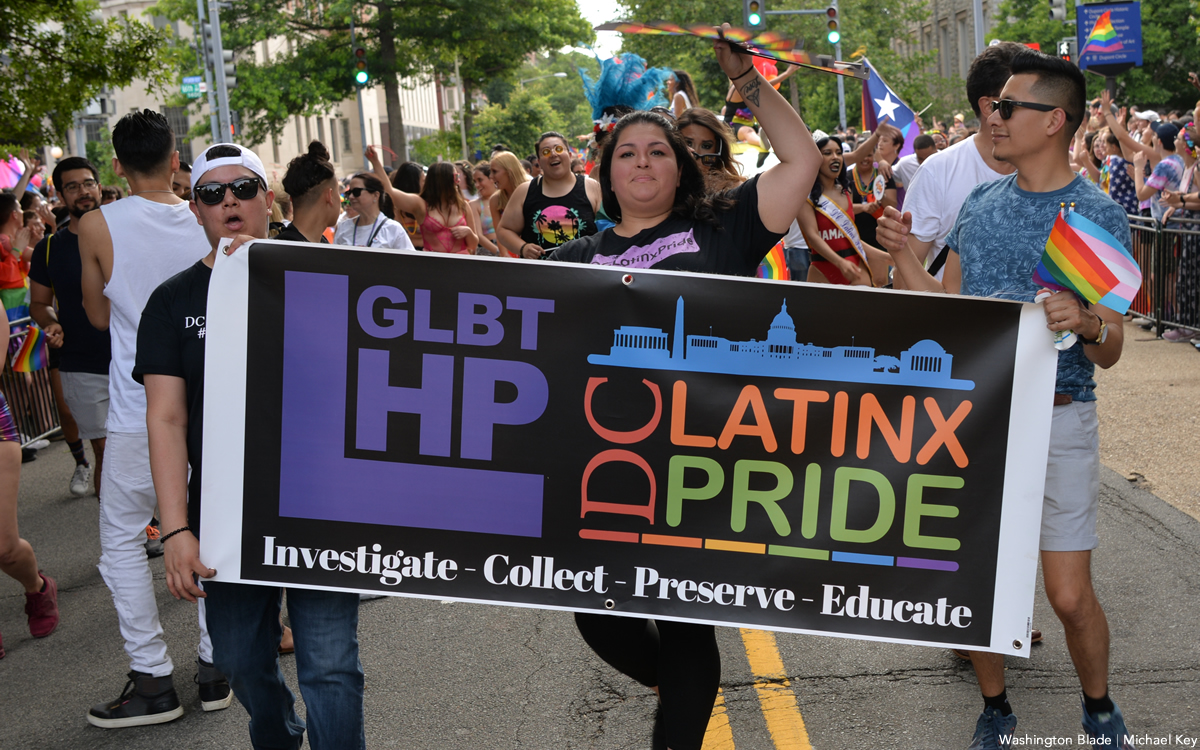
The Latinx History Project will host its 18th annual Latinx Pride with a series of 11 events this year.
Latinx History Project, or LHP, was founded in 2000 to collect, preserve and share Latinx LGBTQ+ History. Six years later, they began hosting DC Latinx Pride.
Board member Dee Tum-Monge said organizers saw a need for the event that centered Latinx community members.
“LHP knows our queer history as Latinx folks has most often been lost to generations of colonialism and imperialism,” they said. “Which is why we focus on documenting and highlighting the impact our community has in D.C. and beyond.”
According to UCLA School of Law, there are more than two million Latinx LGBTQ adults that live in the U.S.
“Events specifically for the Latinx community are important not only to make our experience visible but also to create spaces where we can grow closer with other groups and each other,” said Tum-Monge.
This year they kicked off DC Latinx Pride with a crowning ceremony for their royal court on May 31.
Their three-part series, “La Sanación”, is underway with part two planned for June 16.
“Sanación in Spanish means ‘healing’ which is a big part of what we want to bring to Pride,” said Tum-Monge. “Our communities go through a lot of trauma and hate, but we know there’s more to us. Our goal is to foster connection with ourselves, nature, community, and spirituality.”
In conjunction with the series there is a slate of other events; tickets can be purchased at latinxhistoryproject.org/pride.
In addition, Latinx Pride will march in the Capital Pride Parade on Saturday and participate in the festival on Sunday. To stay involved with Latinx History Project after Pride and hear more about future events visit latinxhistoryproject.org.
-
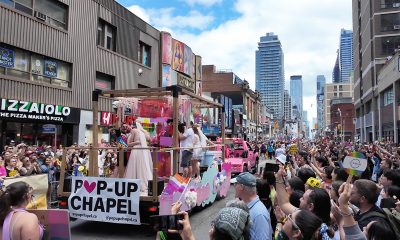
 Canada2 days ago
Canada2 days agoToronto Pride parade cancelled after pro-Palestinian protesters disrupt it
-
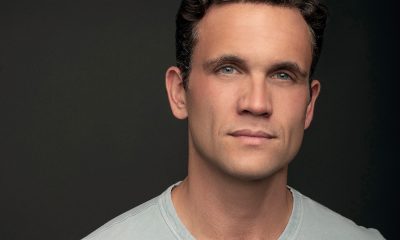
 Theater5 days ago
Theater5 days agoStephen Mark Lukas makes sublime turn in ‘Funny Girl’
-
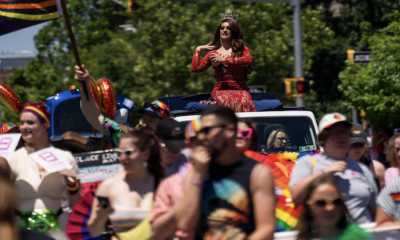
 Baltimore4 days ago
Baltimore4 days agoDespite record crowds, Baltimore Pride’s LGBTQ critics say organizers dropped the ball
-

 Sports4 days ago
Sports4 days agoHaters troll official Olympics Instagram for celebrating gay athlete and boyfriend

